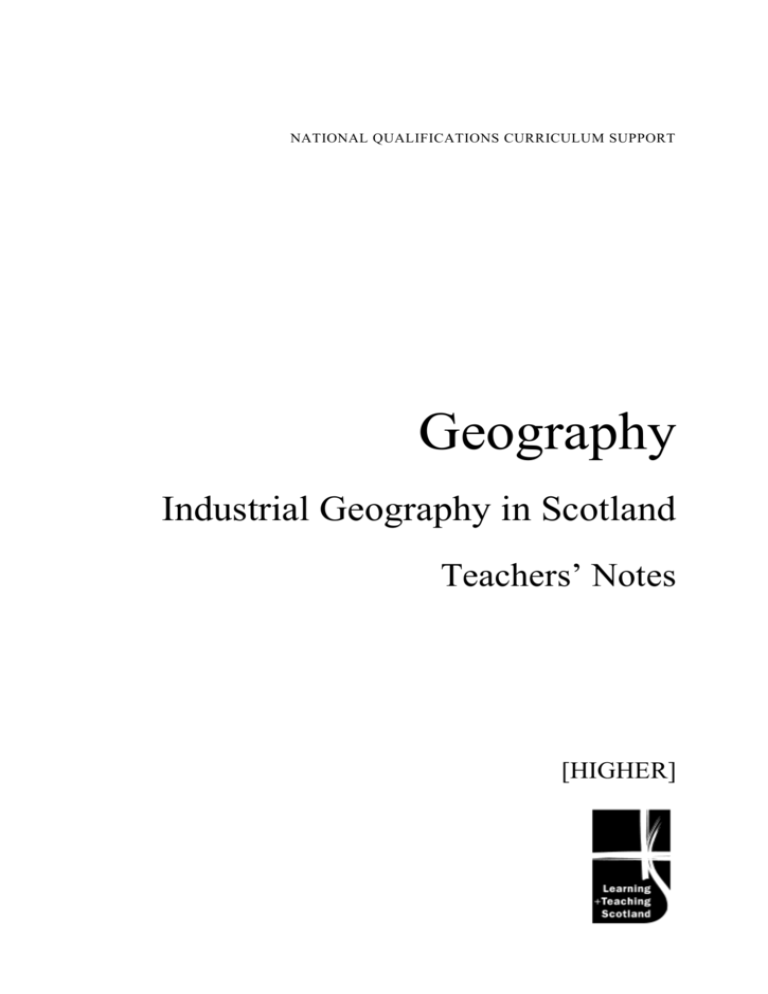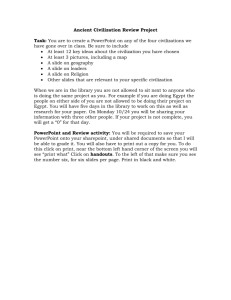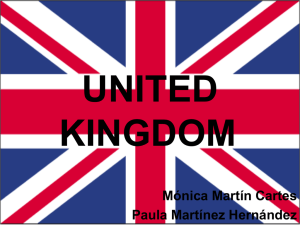Morality and Islam - Education Scotland
advertisement

NATIONAL QUALIFICATIONS CURRICULUM SUPPORT Geography Industrial Geography in Scotland Teachers’ Notes [HIGHER] The Scottish Qualifications Authority regularly reviews the arrangements for National Qualifications. Users of all NQ support materials, whether published by Learning and Teaching Scotland or others, are reminded that it is their responsibility to check that the support materials correspond to the requirements of the current arrangements. Acknowledgement Learning and Teaching Scotland gratefully acknowledges this contribution to the National Qualifications support programme for Geography. The publishers would like to acknowledge the use of the following images in the PowerPoint presentations: 000-000-187-774-R @Royal Commission on the Ancient and Historical Monuments of Scotland. Licensor www.scran.ac.uk; 000-000-039-736-R @ The Scotsman Publications Ltd. Licensor www.scran.ac.uk; 000-000-129-356-R @ Rolls-Royce Heritage Trust Scotland. Licensor www.scran.ac.uk; 000-000-057-132-R @ The Scotsman Publications Ltd. Licensor www.scran.ac.uk; 000-299-993-443-R @ Royal Commission on the Ancient and Historical Monuments of Scotland. Licensor www.scran.ac.uk; 000-000-571-836-R @ SECF Project. Licensor www.scran.ac.uk; 000-000-557-453-R @ Archive Services, University of Dundee. Licensor www.scran.ac.uk; 000-000-187-921-R @ Royal Commission on the Ancient and Historical Monuments of Scotland. Licensor www.scran.ac.uk; 000-000-115-025-R @ Newsquest (Herald & Times). Licensor www.scran.ac.uk; 000-000-198-904-R @ Almond Valley Heritage Trust. Licensor www.scran.ac.uk © Learning and Teaching Scotland 2009 This resource may be reproduced in whole or in part for educational purposes by educational establishments in Scotland provided that no profit accrues at any stage. 2 INDUSTRIAL GEOGRAPHY IN SCOTLAND (H, GEOGRAPHY) © Learning and Teaching Scotland 2009 Contents Teachers’ notes Introduction Curriculum for Excellence Assessment is for Learning Resources Industrial systems Industrial change 8 11 INDUSTRIAL GEOGRAPHY IN SCOTLAND (H, GEOGRAPHY) © Learning and Teaching Scotland 2009 4 5 6 3 TEACHERS’ NOTES Teachers’ notes Introduction Higher Geography has three compulsory units: Physical Environments, Human Environments and Environmental Interactions. Each par t is separated into a series of topics that students should study. These notes are based around a number of resources from the Human Environment section, focusing on the core topic of Industrial Geography. Industrial Geography has a number of themes which students should be aware of. These themes are industrial systems, industrial landscapes and industrial change. Students should also draw on examples of case studies from the EU , therefore each education establishment may have different case studies. However, these notes and resources are aimed to aid all establishments. Furthermore, the Industrial Landscape section focuses on Ordnance Survey mapping, therefore resources are limited here. The resources produced here are intended to be media enriched and incorporate the purposes and principles of Curriculum for Excellence and Assessment is for Learning. There is a major theme of industry in Scotland emerging from these resources. Further examples can be drawn from across the EU. These resources tend not to focus on specific case studies in order to give teachers and students the liberty to select appropriate case studies from their local area. The notes which follow take you through each of the resources , suggesting possible approaches to learning and teachi ng. 4 INDUSTRIAL GEOGRAPHY IN SCOTLAND (H, GEOGRAPHY) © Learning and Teaching Scotland 2009 TEACHERS’ NOTES Curriculum for Excellence The resources compiled to support the teaching of Higher Geography Core Topic Industry support the main aims of Curriculum for Excellence , encouraging all young people to become: 1. 2. 3. 4. successful learners confident individuals responsible citizens effective contributors. These resources encourage the four capacities in the following way: 1. Successful learners Increasing enthusiasm by incorporating a variety of teaching styles and media-rich resources into the learning experience . Developing students' debating skills to justify their decisions. Thinking creatively by forming opinions. Encouraging independent learning and personal responsibility. 2. Confident individuals Taking responsibility for own learning. Respecting other ways of life. Developing discussion skills. Encouraging students to make informed decisions with the data given. Increasing skills in organisation, planning and communication. 3. Responsible citizens Respecting others, especially in understanding social and econom ic industrial decline. Developing an understanding of different ways of life, past and present, and having a sense of respect for them. Developing an understanding of Scotland’s industrial sector and its place in the rest of the world. 4. Effective contributors Improving communication skills through different methods, both formally and informally. Communicating effectively as an individual and as a group. Problem-solving skills developed. Partnership working with peers to complete tasks. INDUSTRIAL GEOGRAPHY IN SCOTLAND (H, GEOGRAPHY) © Learning and Teaching Scotland 2009 5 TEACHERS’ NOTES Assessment is for Learning The resources developed in this unit support the key features of Assessment is for Learning (AifL). The resources help teachers to provide feedback to students to improve their learning by incorporating and encouraging a variety of approaches: providing students with learning outcomes for each resource peer assessment to involve students in their learning and encouraging students to provide constructive feedback in tasks variety of questioning techniques encouraged throughout encouraging feedback in terms of what was done well and areas for development. 6 INDUSTRIAL GEOGRAPHY IN SCOTLAND (H, GEOGRAPHY) © Learning and Teaching Scotland 2009 RESOURCES Resources The following resources cover the main parts of the Industry topic at Higher. The resources can be separated under the two headings of Industrial systems and Industrial change. However, due to the course content, there is some overlapping between the two categories. Industrial systems Industry introduction video Industry video Industrial location question PowerPoint Location factor PowerPoint Sectors of industry PowerPoint Thinking skills PowerPoint Industry extension Microsoft Word Industrial system task Microsoft Word Industrial change Hidden picture task PowerPoint Industrial estate PowerPoint Industrial decline Scotland PowerPoint River Clyde shipbuilding PowerPoint Industry revision question Microsoft Word Task sheet industry estate Microsoft Word INDUSTRIAL GEOGRAPHY IN SCOTLAND (H, GEOGRAPHY) © Learning and Teaching Scotland 2009 7 RESOURCES Industrial systems Industry videos There are two industrial videos. They could be used for revision purposes on completion of the topic or as a resource to support learning wi thin the industry topic. The videos could be used in the following ways: Allow students to watch the video two or three times, on the first occasion to see the content of the video and on the second/third occasion to write down the answers to the questions asked. Additional questions could be posed to back up what the video portrays. The videos could be used as a thinking skills task ‘3-5-7’. This involves students noting down three points from the video. Students then discuss their three points with a partner, together trying to make three points into five. Thereafter, the partners turn to neighbouring partners and discuss their findings, with the idea of working collaboratively to make five points into seven. The results can then be presented to the re st of the class. The final task involves the whole class creating a suitable summary based on all of their findings. Industry video answer grid 1 2 3 4 5 6 7 8 9 10 11 12 13 14 15 16 8 Tertiary/quaternary Primary Secondary Secondary Tertiary Secondary Tertiary Secondary Secondary Secondary Secondary Tertiary Tertiary Tertiary Primary Tertiary INDUSTRIAL GEOGRAPHY IN SCOTLAND (H, GEOGRAPHY) © Learning and Teaching Scotland 2009 RESOURCES Industrial location question PowerPoint This question can be completed individually or in groups. The activity incorporates peer assessment. The PowerPoint takes students through the task step by step. Slide 2 asks two questions, which students should answer under exam conditions. Students should have knowledge of industrial location factors and industrial change. Once students have completed the two questions, they should read and assess their partner’s work. They should be instructed to award marks where appropriate. This will help students prepare for their external geography exam. Students should try and give feedback for each question which clea rly highlights where their partner could improve on their answer. Students should swap back work once they have finished, and try and improve their own work by using the feedback and knowledge gained from reading their partner’s work. Once students are happy with their work, the teacher should go on to the next two questions (slide 5) and repeat the process. Location factor PowerPoint This PowerPoint should be used to provide background information on reasons why industries locate where they do. By the end of the PowerPoint, students should be able to do two things: understand what physical and human factors mean and explain reasons for industrial location. Slide 4 is a question to help create a variety of tasks. This question asks students to think about the physical and human factors which they have listed, and to come up with definitions of physical factors and human factors. The diagram in slide 5 is used to highlight the location factors of industry (flat land, raw materials, land/site, power sourc e). Sectors of industry PowerPoint This PowerPoint presentation should be used to introduce the definitions of the different types of industry. Students could make notes of this in their jotters. The picture at the start of this PowerPoint, showing a heavy manufacturing industry plant, could be used as an introduction to what an old industrial area looks like. However, it would be important to point out that there are other sectors of industry to be studied in this topic; Primary, Secondary, Tertiary, Quaternary. INDUSTRIAL GEOGRAPHY IN SCOTLAND (H, GEOGRAPHY) © Learning and Teaching Scotland 2009 9 RESOURCES There is a task based on some pictures of different types of industry where students are to state to what sector of industry each picture belongs. This task could be done as a class discussion or students could work independently: Picture Picture Picture Picture 1 2 3 4 Primary (taking fish from the sea) Secondary (making a ship) Primary (taking coal from the land) Two possible answers (office block: typically service or perhaps quaternary if researching) The final task involves students stating what the jobs in each of the four explosions belong to: explosion 1 red (primary), explosion 2 yellow (service/tertiary), explosion 3 green (quaternary), explosion 4 blue (manufacturing/secondary). This activity could be extended by getting students to compile a list of jobs using the ‘3-5-7’ approach. Thinking skills PowerPoint Two signs, one saying agree and the other saying disagree, should be positioned on opposite walls. Students should stand in the middle of the room quietly with no discussion taking point at this time. Students should move silently to agree or disagree when they see the question ; notice that there is no sign for unsure. Students must be able to justify the reasons why they have agreed or disagreed. This should open up a channel of discussion/debate between the two sides of the room. Industry extension activity This resource is an extension activity to help students consolidate learning. It could also be used as a homework task. Industrial system task sheet This worksheet incorporates notes to explain industry as a system with inputs, processes and outputs. Prior learning at Standard Grade and Intermediate Geography topics of industry and farming should provide background information on this area. To support learning further, the re is an activity attached to this which will allow students and teachers to assess their understanding. 10 INDUSTRIAL GEOGRAPHY IN SCOTLAND (H, GEOGRAPHY) © Learning and Teaching Scotland 2009 RESOURCES Industrial change Hidden picture task This is an interactive task (game) aimed to help students learn about industry in a fun and competitive manner. It is based on the popular game of Catchphrase, where students answer a question to reveal part of a diagram. This resource can be used for revision purposes or as an extension task. It can be used as a whole-class exercise where the teacher selects students to answer a question. If a student gets the answer correct, the teacher clicks on the coloured box to reveal a segment of the picture. The student who correctly answered the question may attempt to guess what the picture is. This resource could also be used as a written task, where students answer the questions under exam conditions. The teacher could then use peer assessment to mark the student answers. Once the picture is revealed it can lead to a class discussion on the particular theme. For example, a discussion on heavy industry, location factors or declining industry could emerge. This resource can be easily adapted to suit other topics of the Higher course or perhaps other areas of the curriculum. To change the questions you simply delete the existing question and put in the new question of your choice. You can also change the diagram to incorporate the different themes of the course. Industrial estate PowerPoint This PowerPoint allows students to move away from old industry and concentrate on newer types of industry. It looks at why and where industrial estates locate. The PowerPoint gives a list of industrial estates in some local areas. This is to try to help students visualise what an industrial estate may be like. The PowerPoint picks one Scottish industrial estate and uses an aerial photograph to highlight the location factors. The PowerPoint asks students to recap their learning by explaining in detail why industrial estates locate where they do. Industrial decline Scotland Industries started to decline in many parts of Scotland for a number of reasons. This PowerPoint suggests possible reasons for why this happened and explores the consequences. INDUSTRIAL GEOGRAPHY IN SCOTLAND (H, GEOGRAPHY) © Learning and Teaching Scotland 2009 11 RESOURCES River Clyde shipbuilding PowerPoint A Scottish case study to explore changing indu stries. It explores why shipbuilding became so popular on the Clyde and examines its decline. This PowerPoint backs up what was said previously about the consequences of decline in the Industrial decline PowerPoint. Industry revision question Microsoft Word This revision activity could be used as an assessment under exam conditions as it allows for a possible mark out of 25. However, it could be marked formally by the student’s peers. The extension task attached allows students to see images associated with industry and annotate them accordingly to boost their learning. Answers will depend on individual case studies. Students should be encouraged to develop their own marking guidelines if peer assessing. Examples can be drawn from the SQA website, where exemplars from past papers can be viewed. Industry estate task sheet Microsoft Word This sheet on industrial estates reaffirms what was previously said in the Industrial estate PowerPoint. It allows students to annotate the diagram of the industrial estate and conclude with a summary of their findings on location. 12 INDUSTRIAL GEOGRAPHY IN SCOTLAND (H, GEOGRAPHY) © Learning and Teaching Scotland 2009




